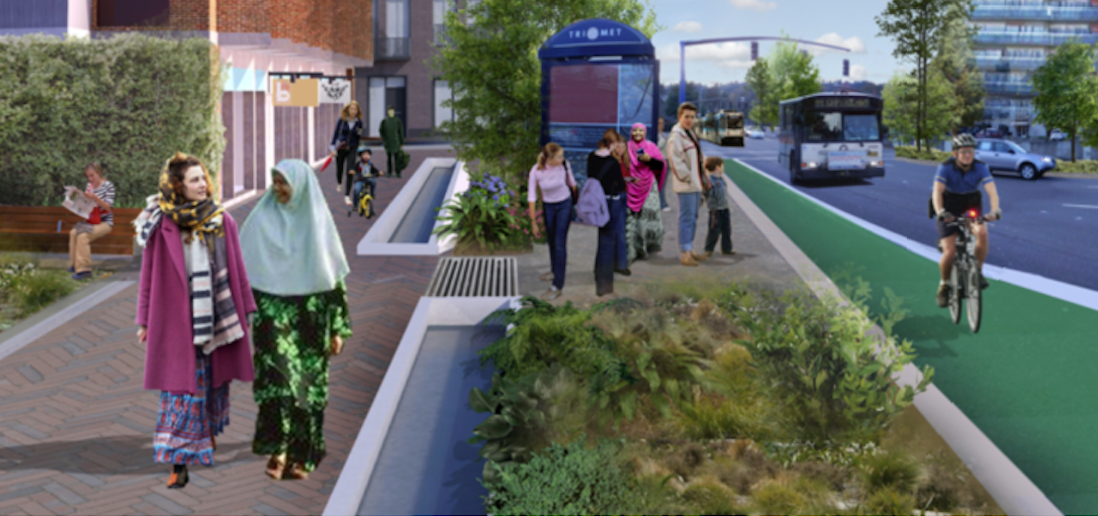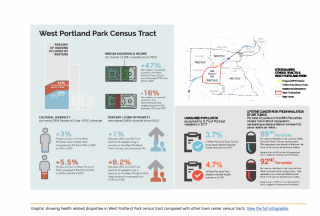
This week, the Bureau of Planning and Sustainability (BPS) released the long-awaited Proposed Draft of their West Portland Town Center Plan (WPTC). It “leads with a health and racial equity lens” and the WPTC effort has baked in anti-displacement policy into every aspect of their ambitious plan. If they can maintain the diversity and affordability of the Town Center as it grows, this will be a showcase for equitable development.

The purpose of the Town Center designations is to use public investment and zoning changes to jump start private investment in the Center as part of an overall city-wide growth strategy. This particular Town Center covers an area dominated by I-5 and SW Barbur Blvd, and sits astride “The Crossroads,” where SW Capitol Hwy, Barbur Blvd and I-5 meet in a starburst pattern.
The Crossroads is car-dominated, with longstanding infrastructure deficiencies which have hindered building travel networks for people walking and on bicycles. Barbur Blvd is a “high-crash corridor,” and the Crossroads intersection is in the top 10% of the statewide Safety Priority Index System. The intersection is also the target of ODOT’s $3 million Barbur Crossroads Safety Project, scheduled to break ground this year.
The public investment would begin with the land under the Barbur Blvd Transit Center, a park-and-ride sandwiched between I-5 and Barbur Blvd.
Advertisement
Consistent with leading with a “racial equity lens,” the report’s Introduction emphasizes West Portland Park (WPP), a neighborhood which is home to an Arab and East African immigrant community. A commissioned demographic study in Appendix B compared WPP to other neighborhoods in the region along key demographic features such as race/ethnicity, income and education level, among others.
I ran into a couple of roadblocks with the demographic study which prevented me from fully understanding the special significance of WPP. One, the “study area” to which WPP was compared came from census tracts which appear to extend beyond the Town Center boundaries into more affluent neighborhoods to the north and east. Although the demographic report was interesting, it did not seem specific to the WPTC. And two, I could not find any hard numbers (just percentages) for WPP and “the WPTC Study Area” — I was unable to learn how many people the report was talking about. (BikePortland has contacted BPS to verify the accuracy and completeness of these observations and will update this article when we have more information.)
An earlier BPS report, The Barbur Concept Study of 2013, identifies “resolving the congestion issues and improving the street design to better accommodate all users” as the “real catalyst” to growth near the Crossroads. Improving congestion issues and accommodating all users, in turn, depend on the cooperation of ODOT and investment in stormwater infrastructure. The WPTC draft plan does not boldly address either of these issues. Along with the fate of the Southwest Corridor light rail project, they remain uncertainties.
Of transportation and stormwater deficiencies north of I-5, the plan states that
Allowing sufficient amounts of new housing to be developed gradually over time in this area is critical to providing a population large enough to create the market demand for new commercial amenities nearby … It will also support needed transportation and stormwater infrastructure improvements.
This build first, figure out the infrastructure bit later, leads to large gaps in the cycling network, and perpetuates southwest Portland’s position of having the least sidewalk coverage in the city.
The WPTC team invites your feedback in anticipation of a hearing before Portland’s Planning and Sustainability Commission. From there the Commission presents their amended version of the plan to the City Council in late fall or early winter.

— Lisa Caballero, lisacaballero853@gmail.com
— Get our headlines delivered to your inbox.
— Support this independent community media outlet with a one-time contribution or monthly subscription.


